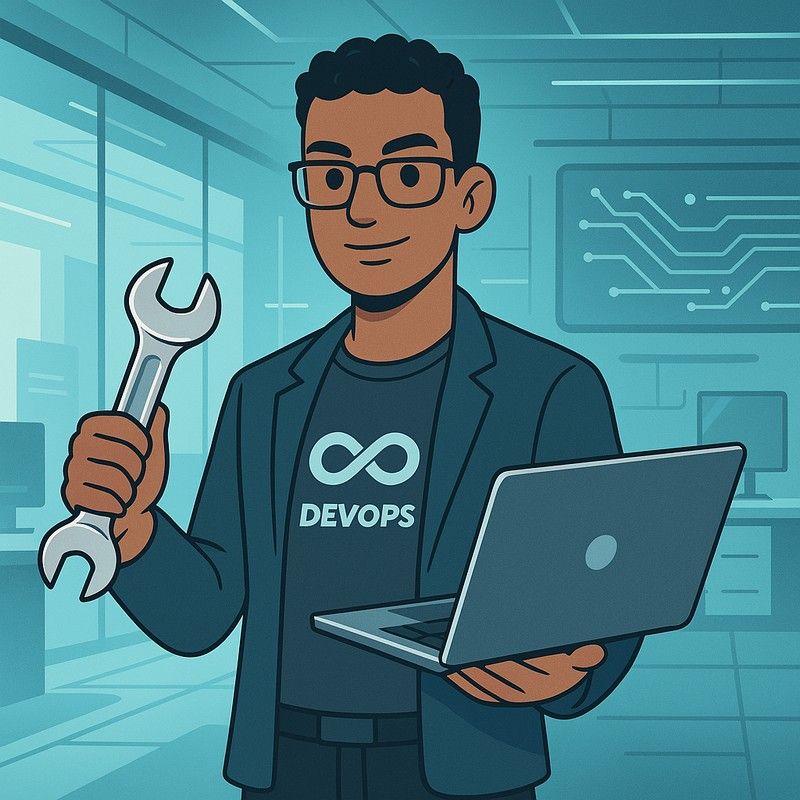- java
- devops
- infrastructure
What is maven in devops?
Apr 16, 2025
-
Damian Szewczyk
-
21 minutes

Maven streamlines Java project development by automating builds, managing dependencies, and standardizing workflows. This Apache Software Foundation tool operates on "convention over configuration" principles, reducing manual setup while enhancing productivity across development teams. Its robust dependency management system automatically resolves library requirements, making it essential for large-scale enterprise projects.
Maven is a build automation tool that manages the entire project lifecycle from compilation and testing to deployment. It uses an XML-based Project Object Model (POM) file to define project configurations, dependencies, and build sequences. Unlike manual build processes, Maven automates repetitive tasks while ensuring cross-environment compatibility.
Developers choose Maven for four primary benefits:
Manages dependencies by automatically downloading required libraries from central repositories
Automates build processes including compiling, testing, and packaging applications
Ensures consistency across different development environments through standardized configurations
Streamlines collaboration by maintaining uniform project structures for team members
These capabilities significantly reduce project setup time while minimizing "works on my machine" issues that plague development teams.

Maven operates on a structured system of conventions and configurations that form its functional backbone. The architecture consists of three primary components:
The POM file forms Maven's operational core by defining all project specifications in XML format. This configuration file specifies project details, dependencies, build settings, and deployment information. The POM follows a hierarchical structure where child modules inherit settings from parent POMs, ensuring consistency across multi-module projects.
A basic POM includes:
<project> <modelVersion>4.0.0</modelVersion> <groupId>com.example</groupId> <artifactId>my-app</artifactId> <version>1.0-SNAPSHOT</version> <packaging>jar</packaging> </project>Maven retrieves dependencies from three repository types:
Local repository stores downloaded dependencies in your .m2 directory
Central repository provides access to public open-source libraries
Remote repositories host private or third-party libraries
When you request a dependency, Maven first checks the local repository before searching remote sources, optimizing build performance through intelligent caching.
Maven orchestrates project builds through predefined lifecycles divided into sequential phases. Each phase represents a stage in the project build process. The three primary lifecycles include:
Default lifecycle handles project deployment with phases like compile, test, package, and install
Clean lifecycle removes previous build files
Site lifecycle generates project documentation
When you execute a phase (e.g., mvn install), Maven automatically runs all preceding phases in sequence, ensuring complete process execution.

Maven and Gradle both automate builds, but Maven uses declarative XML configuration while Gradle employs Groovy-based scripting for greater flexibility. This fundamental difference shapes their capabilities and use cases.
| Feature | Maven | Gradle |
|---|---|---|
| Configuration | XML-based (declarative) | Groovy/Kotlin-based (imperative) |
| Learning Curve | Lower entry barrier | Steeper learning curve |
| Performance | Slower builds | Faster due to incremental compilation |
| Customization | Limited without plugins | Highly customizable |
| Community Support | Extensive documentation | Growing ecosystem |
| Best For | Structured enterprise projects | Complex, customized builds |
Maven excels in environments requiring standardization and predictability, making it ideal for enterprise Java applications. Its convention-over-configuration approach reduces decision fatigue for development teams.
Gradle provides superior performance for large-scale projects through incremental builds and build cache features. Its scripting capabilities enable complex customizations that would require extensive plugin development in Maven.
Maven revolutionizes project dependencies by automatically retrieving libraries from repositories and resolving version conflicts. This eliminates manual JAR file management while ensuring build consistency across environments.
Maven defines five dependency scopes that control when libraries are available:
Compile scope (default) makes dependencies available during compilation, testing, and runtime
Provided scope makes dependencies available during compilation but expects the runtime environment to provide them
Runtime scope excludes dependencies during compilation but includes them during testing and runtime
Test scope limits dependencies to the testing compilation and execution phases
System scope references system path dependencies instead of repositories
Properly scoping dependencies optimizes application performance by preventing unnecessary library inclusion.
Example of properly scoped dependencies:
<dependencies> <!-- Available in all phases --> <dependency> <groupId>org.apache.commons</groupId> <artifactId>commons-lang3</artifactId> <version>3.12.0</version> <scope>compile</scope> </dependency> <!-- Only needed for tests --> <dependency> <groupId>junit</groupId> <artifactId>junit</artifactId> <version>4.13.2</version> <scope>test</scope> </dependency> </dependencies>Maven resolves version conflicts using a "nearest definition" algorithm that prioritizes dependencies defined closest to your project in the dependency tree. When conflicts occur, use these techniques:
Analyze dependency trees with mvn dependency:tree to identify conflicts
Exclude problematic transitive dependencies using exclusion tags
Define version management in parent POMs using <dependencyManagement>
Example of dependency exclusion:
<dependency> <groupId>org.springframework</groupId> <artifactId>spring-core</artifactId> <version>5.3.9</version> <exclusions> <exclusion> <groupId>commons-logging</groupId> <artifactId>commons-logging</artifactId> </exclusion> </exclusions> </dependency>Maven lifecycles provide structured sequences of phases that process your project from compilation to deployment. This system ensures consistent build processes across projects while allowing customization through plugins.
The default lifecycle includes these key phases:
Compile transforms source code into binary files
Test runs unit tests without requiring packaging
Package bundles compiled code into distributable formats (JAR, WAR)
Install places packages in the local repository for use as dependencies
Deploy copies packages to remote repositories for sharing
When you execute mvn install, Maven automatically runs all preceding phases (compile, test, package) before performing installation.
Maven's build process adapts to project requirements through:
Custom plugins that introduce new capabilities
Build profiles that activate environment-specific configurations
Properties that parameterize build settings
Example of a profile configuration:
<profiles> <profile> <id>dev</id> <properties> <db.url>jdbc:mysql://localhost/devdb</db.url> </properties> </profile> <profile> <id>prod</id> <properties> <db.url>jdbc:mysql://prodserver/proddb</db.url> </properties> </profile> </profiles>Activate profiles using the command line parameter: mvn clean install -Pprod
Maven plugins extend functionality by introducing custom goals that integrate with the build lifecycle. These components form the cornerstone of Maven's extensibility, allowing developers to customize build processes for specific project requirements.
Developers regularly use these plugins to enhance build capabilities:
Compiler plugin configures Java source and target versions
Surefire plugin executes unit tests during the test phase
JAR plugin packages compiled code into JAR files
War plugin packages web applications as WAR files
Dependency plugin analyzes and manages project dependencies
Example of compiler plugin configuration:
<plugin> <groupId>org.apache.maven.plugins</groupId> <artifactId>maven-compiler-plugin</artifactId> <version>3.8.1</version> <configuration> <source>11</source> <target>11</target> </configuration> </plugin>
For specialized requirements, developers create custom plugins using:
Maven Archetype Plugin to generate plugin project structure
Java or Scripting languages to implement plugin logic
Annotations to define plugin parameters and goals
Custom plugins extend Maven's capabilities for unique build requirements, from code generation to specialized deployment procedures.
Maven excels at managing multi-module projects by coordinating builds across interconnected components while maintaining centralized configuration. This approach supports large applications with modular architectures, enhancing maintainability and enabling parallel development.
A typical multi-module project includes:
Parent module containing shared configurations and defining module relationships
Child modules representing individual components with specific functionalities
The directory structure follows this pattern:
parent-project/ ├── pom.xml (Parent POM) ├── module-a/ │ └── pom.xml ├── module-b/ │ └── pom.xml ├── module-c/ │ └── pom.xmlThe parent POM defines shared elements:
<project> <modelVersion>4.0.0</modelVersion> <groupId>com.example</groupId> <artifactId>parent-project</artifactId> <version>1.0-SNAPSHOT</version> <packaging>pom</packaging> <modules> <module>module-a</module> <module>module-b</module> <module>module-c</module> </modules> <dependencyManagement> <!-- Centralized dependency versions --> </dependencyManagement> </project>Child modules reference the parent:
<project> <parent> <groupId>com.example</groupId> <artifactId>parent-project</artifactId> <version>1.0-SNAPSHOT</version> </parent> <artifactId>module-a</artifactId> </project>This structure enables:
Centralized dependency management through parent POM configuration
Consistent versioning across related modules
Optimized builds with targeted module compilation
Maven seamlessly integrates with CI/CD pipelines, automating builds and deployments within modern DevOps workflows. This integration ensures consistent, repeatable processes from development through production.
Maven works with popular CI/CD tools using specialized configurations:
Jenkins integration:
pipeline { agent any stages { stage('Build') { steps { sh 'mvn clean install' } } stage('Test') { steps { sh 'mvn test' } } } }GitHub Actions implementation:
name: Maven Build on: [push] jobs: build: runs-on: ubuntu-latest steps: - uses: actions/checkout@v3 - name: Set up JDK 11 uses: actions/setup-java@v3 with: java-version: '11' - name: Build with Maven run: mvn clean installGitLab CI/CD configuration:
build: stage: build script: - mvn clean installAccelerate CI/CD pipelines with these Maven optimizations:
Cache dependencies between pipeline runs to avoid repeated downloads
Enable parallel builds with the -T option: mvn -T 4 clean install
Configure incremental builds to process only changed modules
Implement build profiles specific to CI/CD environments
These strategies reduce build times while maintaining quality, supporting faster development iterations.
Maven projects face security risks through vulnerable dependencies and insecure configurations. Implementing robust security practices protects applications from supply chain attacks and known vulnerabilities.
Protect your projects with these security measures:
Scan dependencies regularly using specialized tools:
mvn org.owasp:dependency-check-maven:checkAvoid SNAPSHOT dependencies in production environments
Pin dependency versions rather than using version ranges
Exclude vulnerable transitive dependencies when updates aren't available
Secure your Maven environment with these repository practices:
Use HTTPS for repository connections to prevent man-in-the-middle attacks
Implement private repository managers like Nexus or Artifactory with access controls
Verify artifact checksums to ensure dependency integrity
Configure repository mirrors from trusted sources only
Example of secure repository configuration:
<repository> <id>central-secure</id> <url>https://repo.maven.apache.org/maven2</url> </repository>Maven supports cloud-native development by integrating with containerization tools and cloud deployment workflows. This enables seamless packaging and deployment of applications to modern infrastructure platforms.
Maven packages applications as containers through specialized plugins:
Jib Maven Plugin builds containers without Dockerfiles:
<plugin> <groupId>com.google.cloud.tools</groupId> <artifactId>jib-maven-plugin</artifactId> <version>3.3.1</version> <configuration> <to> <image>my-service:latest</image> </to> </configuration> </plugin>Dockerfile Maven Plugin uses traditional Dockerfile approaches:
<plugin> <groupId>com.spotify</groupId> <artifactId>dockerfile-maven-plugin</artifactId> <version>1.4.13</version> <configuration> <repository>my-app-image</repository> <tag>${project.version}</tag> </configuration> </plugin>Maven facilitates deployment to major cloud providers:
AWS Lambda deployments through the aws-lambda-maven-plugin
Google Cloud Run deployments using Jib with GCR integration
Azure App Service deployments via azure-webapp-maven-plugin
These integrations streamline the pipeline from development to cloud deployment, supporting modern application architectures.
Maven build failures stem from dependency conflicts, plugin incompatibilities, or configuration errors. Identifying and resolving these issues requires systematic troubleshooting approaches.
Fix dependency-related issues with these techniques:
Analyze dependency trees to identify conflicts:
mvn dependency:treeForce updates when cached dependencies cause problems:
mvn clean install -UCheck repository connectivity when dependencies fail to download
Implement version management in the dependencyManagement section
Address build process failures through:
Examine build logs to identify exact failure points
Validate plugin configurations against documentation
Verify Java version compatibility between compiler settings and project code
Run builds with increased verbosity:
mvn clean install -XCheck effective POM to see resolved settings:
mvn help:effective-pomThese troubleshooting approaches identify root causes of Maven issues, enabling rapid resolution.
Maven continues evolving to support modern development paradigms while maintaining its core strengths in dependency management and build automation. Its future direction addresses current limitations while expanding capabilities for contemporary workflows.
Maven adapts to changing development landscapes through:
Enhanced cloud integration with specialized plugins for containerization and serverless deployments
Improved performance with incremental build capabilities and parallel execution
Better dependency resolution algorithms to handle complex dependency trees
Expanded ecosystem compatibility with modern frameworks and platforms
Despite competition from newer build tools like Gradle, Maven remains relevant through continuous adaptation and its established position in enterprise development workflows.
Maven provides optimal value for:
Enterprise Java applications requiring standardization and governance
Multi-module projects with shared components and dependencies
Teams transitioning from legacy build systems to modern automation
Projects prioritizing convention over extensive customization
These strengths ensure Maven's continued relevance in the evolving software development landscape.
Maven transforms Java project management by providing a standardized, automated approach to builds and dependencies. Its convention-over-configuration philosophy reduces complexity while ensuring consistency across development environments. Despite newer alternatives, Maven's robust ecosystem, extensive plugin library, and integration capabilities maintain its position as a cornerstone technology for Java development.
Organizations implementing Maven benefit from streamlined workflows, reduced onboarding time, and consistent build processes. Its integration with modern DevOps practices and cloud platforms ensures Maven remains relevant for contemporary software development methodologies. By adopting Maven's best practices for dependency management, module organization, and security, development teams achieve greater productivity while maintaining high-quality software delivery.

What are the signs your startup might need a DevOps engineer? Learn how a DevOps approach can enhance your software development lifecycle and boost deployment efficiency.

Discover the three key attributes that define DevOps! Explore how automation, productivity, and a transformative approach enhance software releases and best practices.

Discover best practices for DevOps testing in this comprehensive guide. Learn how to automate testing with Azure's tools to enhance performance and streamline your strategy.